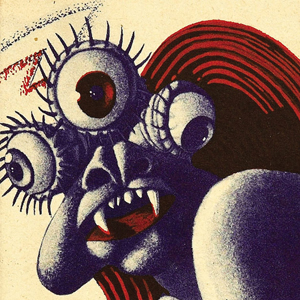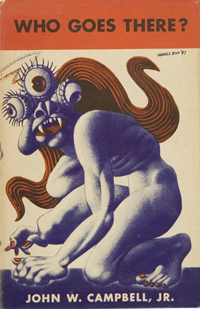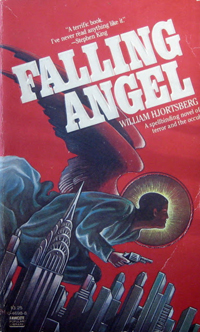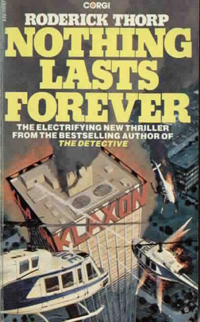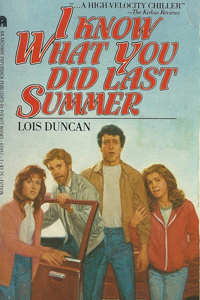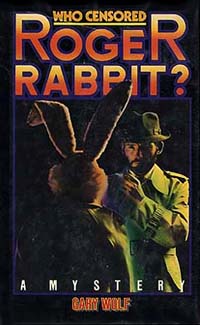Who Goes There? Movies You May Not Know Where Based On Pulp Novels (Part 1)
|
It's not uncommon to adapt books for the screen, but there are a number of movies that it may surprise you, started out as pulp novels, novellas or little known short stories in anthology magazines. There are particularly some classic sci-fi, horror and thriller movies, that were based on works of fiction that could possibly be long forgotten if it wasn't for the existence of their movie version. Many you probably already know of, and have possible even read the book, based on seeing the movie. I'm thinking things like Psycho (1959) by Robert Bloch, that became the famous 1960 Alfred Hitchcock thriller. Or William Peter Blatty's novel The Exorcist from 1971, that was adapted into the seminal demonic possession horror of 1973, directed by William Friedkin. Blatty actually wrote the screenplay and produced the movie version. Although as far as Psycho, Bloch was screwed, as Hitchcock bought the rights anonymously, to avoid paying Bloch too much. Anyway, I digress, and the point is that there are a lot of movies that it may surprise you of their literary origins. Or it may not! You may well be a cinephile and know these already.
|
|
Who Goes There? by John W. Campbell, Jr. (1938): A sci-fi/horror novella, originally published under the pen-name Don A. Stuart. It was first published in the August 1938 edition of Astounding Science-Fiction.
The Movie(s): Who Goes There? Has had three movies based on it. The Thing From Another World (1951), was a loose adaptation. The "Thing" is humanoid, rather than a shape-shifting alien, as in the second adaptation, John Carpenter's The Thing (1982), which is more faithful to the creature in the novella. Then there is the prequel to the 1982 movie, also entitled The Thing, from 2011. In the later two movies, "The Thing" is a shape-shifting alien that can not only change itself to look like another biological entity, absorb their memories as well. The same as in the novella. Also Carpenter lifted scenes from the novella, and placed them directly in the 1982 version of The Thing. The discovery of the semi-transformed sled dog, the idea of the men always watching each other or being in sight of each other, the idea of testing their blood with a heated piece of wire, and that the creature is killed by fire. Among other elements that Carpenter borrowed, or adapted. There is a forth movie, 1972's Horror Express, which is claimed to be a loose adaptation, but is so "loose" it doesn't count as an adaptation in my book. |
|
Falling Angel by William Hjortsberg (1978): A hard-boiled crime / horror novel, that sets it's stall out right at the start with the opening line, "Once upon a time, the devil hired a private detective". The novel came out just as horror fiction was starting to become a popular literary genre, with the likes of Stephen King, Dean Koontz and Peter Straub starting to make a splash. Koontz and especially King would have great success with adaptations of their works. And were starting to around this time, King had his 1974 novel Carrie adapted in 1976, and Koontz his 1973 novel Demon Seed adapted in 1977. The novel Falling Angel was relatively successful when it was published in paperback, and so was prime for being adapted' Hjortsberg however, failed to follow-up on his own success, and it wasn't until 1987 that a movie adaptation was finally made of the novel.
The Movie: Angel Heart (1987), starring Mickey Rourke and Robert De Niro. The movie is pretty faithful to the book, except that the book's location remains entirely in New York City, New York State in 1959. The movie mostly takes place in New Orleans. Also the movie introduced Epiphany Proudfoot's child which she claims was conceived by "a devil" during a voodoo ceremony. |
|
Nothing Lasts Forever by Roderick Thorp (1979): The follow-up thriller/detective novel to Thorp's 1966 novel the Detective, which was adapted into the 1968 movie of the same name, starring Frank Sinatra. The movie was one of the highest-grossing of 1968, and the most commercially successful of Sinatra's career. However, it wasn't until after Thorp saw the 1974 movie The Towering Inferno, that he decided to write a sequel. He originally imagined Frank Sinatra in the movie adaptation, but he declined it. The novel was adapted as a sequel to the Schwarzenegger film Commando (1985), but he too declined it.
The Movie: The script was rewritten, and it became the 1988 smash-hit Die Hard, starring Bruce Willis. The movie stays pretty faithful to the novel. It changes the name of the main character, and makes him younger, to disassociate it from the first novel. Also his daughter changes to his wife, and the American corporation becomes Japanese. The "terrorists" of the novel are really just thieves in the movie, but are still ethnically European (the novel has them as German). The classic movie scene of McClane jumping off an exploding roof with a fire hose attached to his waist, then shooting through a window to gain re-entry, is directly lifted from the novel. |
|
I Know What You Did Last Summer by Lois Duncan (1973): A suspense novel, written for young adults. A convoluted he did it, she did it, novel filled with finger-pointing and unrequited love. Not the "high-velocity chiller" that cover claims. I'll admit, I've not read the novel, and never will. The synopsis was enough to give me a headache and want me to buy a copy just so I could ceremoniously burn it for the good of humanity. However someone must have read it, at least once. Or at least once seen the cover of the novel in passing, and thought that'd make a good movie title one day.
The Movie: Yes, that crappy teen horror of the same name. Who knew it was based on a novel?! Even a novel better utilised as toilet paper, than actually being read. I thought that scripts for movies like I Know What You Did Last Summer were just shit on the page by incontinent script writers just trying to pay the bills. The movie and the novel apparently have little in common, apart from both being major skid-marks on the underwear of culture. Anyway, there you go. I bet you didn't know that piece of crap was based on an even bigger steaming piece of crap. |
|
Who Censored Roger Rabbit? by Gary K. Wolf (1981): A comic hard-boiled mystery novel, that has the detective Valiant investigating the death of the eponymous Roger Rabbit, after Roger had hired Valiant to look into why his employers had reneged on a deal to give him his own comic strip.
The Movie: Obviously it's Who Framed Roger Rabbit?, with the alteration that the rabbit doesn't die at the beginning. The movie borrowed characters from the novel, but pretty much changed everything else. The novel is set in the present, rather than the film-noir 1947 of the movie. The "cartoon" characters of the movie are mostly comic strip characters in the novel. Although like the movie, well known characters do make cameos. Rather than the famous cartoon characters of the movie, we get comic strip greats like Snoopy, Dagwood and Blondie, Beetle Bailey, Dick Tracy and Hägar the Horrible. The characters in the book speak in speech bubbles, which appear above their heads, in-line with them being comic-strip rather than cartoon characters. The only line of dialogue from the book that was re-used in the film was spoken by Baby Herman, saying "I've got a 50-year-old lust and a 3-year-old dinky", though in the book, his actual age is given as 36. |
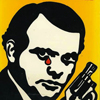
Red Alert! Movies You May Not Know Where Based On Pulp Novels (Part 2) - Another list of obscure novels, that have been made into classic cult movies.
|

Top Ten: Freaky Frankenstein Movies - Bad art-house, B-movie cash-ins, comedies, blaxpolitation, horror and as much marvellously monstrous madness to satisfy everyone's Frankenstein needs.
|

